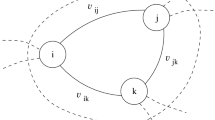Abstract
This paper is concerned with the probability of consensus in a multivariate, socially structured version of the Hegselmann–Krause model for the dynamics of opinions. Individuals are located on the vertices of a finite connected graph representing a social network, and are characterized by their opinion, with the set of opinions \(\Delta \) being a general bounded convex subset of a finite dimensional normed vector space. Having a confidence threshold \(\tau \), two individuals are said to be compatible if the distance (induced by the norm) between their opinions does not exceed the threshold \(\tau \). Each vertex x updates its opinion at rate the number of its compatible neighbors on the social network, which results in the opinion at x to be replaced by a convex combination of the opinion at x and the nearby opinions: \(\alpha \) times the opinion at x plus \((1 - \alpha )\) times the average opinion of its compatible neighbors. The main objective is to derive a lower bound for the probability of consensus when the opinions are initially independent and identically distributed with values in the opinion set \(\Delta \).

Similar content being viewed by others
References
Axelrod, R.: The dissemination of culture: a model with local convergence and global polarization. J. Conflict Resolut. 41(2), 203–226 (1997)
Bramson, M., Griffeath, D.: Renormalizing the \(3\)-dimensional voter model. Ann. Probab. 7(3), 418–432 (1979)
Bramson, M., Griffeath, D.: Clustering and dispersion rates for some interacting particle systems on \({ Z}\). Ann. Probab. 8(2), 183–213 (1980)
Castellano, C., Fortunato, S., Loreto, V.: Statistical physics of social dynamics. Rev. Mod. Phys. 81(2), 591 (2009)
Clifford, P., Sudbury, A.: A model for spatial conflict. Biometrika 60, 581–588 (1973)
Cox, J.T.: Coalescing random walks and voter model consensus times on the torus in \({ Z}^d\). Ann. Probab. 17(4), 1333–1366 (1989)
Cox, J.T., Griffeath, D.: Diffusive clustering in the two-dimensional voter model. Ann. Probab. 14(2), 347–370 (1986)
Deffuant, G., Neau, D., Amblard, F., Weisbuch, G.: Mixing beliefs among interacting agents. Adv. Complex Syst. 3(01n04), 87–98 (2000)
Durrett, R., Steif, J.E.: Fixation results for threshold voter systems. Ann. Probab. 21(1), 232–247 (1993)
Galam, S.: Minority opinion spreading in random geometry. Eur. Phys. J. B 25(4), 403–406 (2002)
Häggström, O.: A pairwise averaging procedure with application to consensus formation in the Deffuant model. Acta Appl. Math. 119, 185–201 (2012)
Hardin, M., Lanchier, N.: Probability of consensus in spatial opinion models with confidence threshold. ArXiv:1912.06746
Hegselmann, R., Krause, U.: Opinion dynamics and bounded confidence models, analysis, and simulation. J. Artif. Soc. Soc. Simul. 5(3), 3–33 (2002)
Hirscher, T.: The Deffuant model on \(\mathbb{Z}\) with higher-dimensional opinion spaces. ALEA Lat. Am. J. Probab. Math. Stat. 11(1), 409–444 (2014)
Holley, R.A., Liggett, T.M.: Ergodic theorems for weakly interacting infinite systems and the voter model. Ann. Probab. 3(4), 643–663 (1975)
Lanchier, N.: The Axelrod model for the dissemination of culture revisited. Ann. Appl. Probab. 22(2), 860–880 (2012)
Lanchier, N.: The critical value of the Deffuant model equals one half. ALEA Lat. Am. J. Probab. Math. Stat. 9(2), 383–402 (2012)
Lanchier, N., Li, H.-L.: Probability of consensus in the multivariate Deffuant model on finite connected graphs. Electron. Commun. Probab. 25, 12 (2020)
Lanchier, N., Neufer, J.: Stochastic dynamics on hypergraphs and the spatial majority rule model. J. Stat. Phys. 151(1–2), 21–45 (2013)
Lanchier, N., Scarlatos, S.: Fixation in the one-dimensional Axelrod model. Ann. Appl. Probab. 23(6), 2538–2559 (2013)
Lanchier, N., Scarlatos, S.: Clustering and coexistence in the one-dimensional vectorial Deffuant model. ALEA Lat. Am. J. Probab. Math. Stat. 11(1), 541–564 (2014)
Lanchier, N., Scarlatos, S.: Limiting behavior for a general class of voter models with confidence threshold. ALEA Lat. Am. J. Probab. Math. Stat. 14(1), 63–92 (2017)
Lanchier, N., Schweinsberg, J.: Consensus in the two-state Axelrod model. Stoch. Process. Appl. 122(11), 3701–3717 (2012)
Li, H.-L.: Mixed Hegselmann-Krause dynamics. ArXiv:2010.03050
Li, H.-L.: Mixed Hegselmann-Krause dynamics – nondeterministic case. ArXiv:2105.00577
Li, J.: Axelrod’s model in two dimensions. ProQuest LLC, Ann Arbor, MI. Thesis (Ph.D.)–Duke University (2014)
Liggett, T.M.: Interacting Particle Systems. Grundlehren der mathematischen Wissenschaften [Fundamental Principles of Mathematical Sciences], vol. 276. Springer-Verlag, New York (1985)
Liggett, T.M.: Coexistence in threshold voter models. Ann. Probab. 22(2), 764–802 (1994)
Liggett, T.M.: Stochastic Interacting Systems: Contact, Voter and Exclusion Processes. Grundlehren der Mathematischen Wissenschaften, vol. 324. Springer-Verlag, Berlin (1999)
Vazquez, F., Krapivsky, P.L., Redner, S.: Constrained opinion dynamics: freezing and slow evolution. J. Phys. A 36(3), L61–L68 (2003)
Zähle, I.: Renormalization of the voter model in equilibrium. Ann. Probab. 29(3), 1262–1302 (2001)
Acknowledgements
The authors would like to thank three anonymous referees for their comments that help improve the presentation and the clarity of this work.
Author information
Authors and Affiliations
Corresponding author
Additional information
Communicated by Pierpaolo Vivo.
Publisher's Note
Springer Nature remains neutral with regard to jurisdictional claims in published maps and institutional affiliations.
Nicolas Lanchier was partially supported by NSF Grant CNS-2000792.
Supplementary Information
Below is the link to the electronic supplementary material.
Rights and permissions
About this article
Cite this article
Lanchier, N., Li, HL. Consensus in the Hegselmann–Krause Model. J Stat Phys 187, 20 (2022). https://doi.org/10.1007/s10955-022-02920-8
Received:
Accepted:
Published:
DOI: https://doi.org/10.1007/s10955-022-02920-8
Keywords
- Interacting particle systems
- Hegselmann–Krause model
- Opinion dynamics
- Martingale
- Martingale convergence theorem
- Optional stopping theorem
- Confidence threshold
- Consensus




